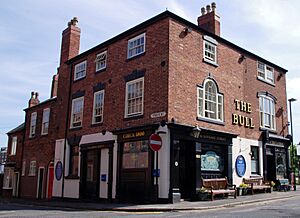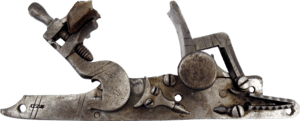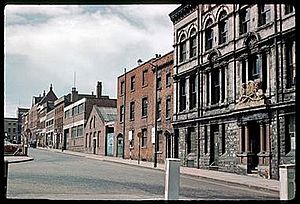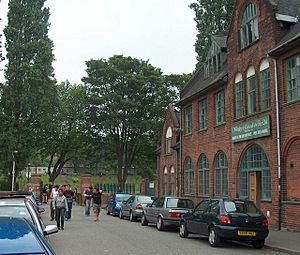Gun Quarter facts for kids
The Gun Quarter is a special area in Birmingham, England. For many years, it was a global hub for making guns. Workers here made military weapons and sporting guns. This industrial area is just north of the city centre. It is bordered by Steelhouse Lane, Shadwell Street, and Loveday Street.
Birmingham's first gun maker was recorded in 1630. Muskets made locally were used in the English Civil War. By the 1690s, Birmingham workers supplied guns for King William III. These guns equipped the English Army, and later the British Army. The gun trade grew fast in the 18th century. Many guns were made for the slave trade.
The 19th century saw even more growth. The Gun Quarter supplied guns for the Napoleonic Wars, Crimean War, and American Civil War. It also supplied weapons for the British Empire. During both the First and Second World Wars, the area made many small arms for the British Armed Forces.
After World War I, demand for guns dropped. Cheaper, machine-made guns became common. This meant less need for skilled gun makers. Gun manufacturing in the area slowly declined. In the 1960s, city planners tore down much of the Gun Quarter. The building of the Birmingham Inner Ring Road split the area in two.
Since the Big City Plan of 2008, the Gun Quarter is part of Birmingham City Centre. Many buildings are empty, but there are plans to rebuild. This includes areas on Shadwell Street and Vesey Street.
Contents
History of Gun Making
Why Birmingham Made Guns
Birmingham became a world leader in gun making. This was because Britain was often involved in wars. From the 1600s to the 1900s, Britain's wars created a constant need for weapons. The British Empire grew hugely during this time. This meant even more demand for guns. Guns were needed for expansion, control, and to stop problems in its colonies.
In the 18th century, at the start of the Industrial Revolution, tens of thousands of guns were made. By the 19th century, this number grew to millions.
17th Century Gun Trade
In the early to mid-17th century, Birmingham was a small town. It had many workshops that made metal items, including guns. In 1689, Sir Richard Newdigate asked local makers to supply guns to the British Government. He stressed that these guns needed to be as good as those imported from other countries.
After a successful test in 1692, the Government placed its first order. On January 5, 1693, "Officers of Ordnance" chose five local gun makers. They were to make 200 "snaphance musquets" each month for a year. They paid 17 shillings per musket. They also paid 3 shillings per hundredweight for delivery to London.
18th Century Gun Quarter
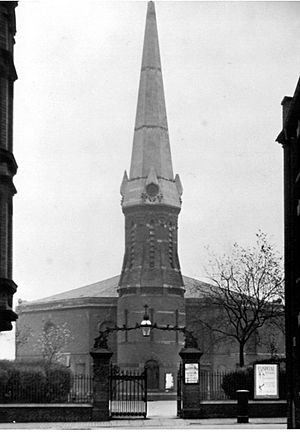
At the start of the 18th century, gun making was in the Digbeth area. But 50 years later, the trade moved to the Gun Quarter. Many gunsmiths also moved to less crowded parts of the city. The Gun Quarter was a very small area. Early reports describe many crowded houses and factories. Different gun shops and makers were very close to each other.
A plaque in the Gun Quarter says that Birmingham was the "foremost arms producer in the world" around this time. London was the town's closest rival.
By the end of the 18th century, the Gun Quarter was a busy gun-making community. Government inspection rooms opened in Bagot Street in 1798. About 60 or 70 people worked there. They made sure guns met the standards for the British army.
However, a big market for guns was the Atlantic slave trade. A 1788 report to Parliament counted over 4,000 gun makers. It said 100,000 guns a year went to slave traders.
19th Century Gun Boom
The British Government relied heavily on Birmingham's skilled gun makers. The Napoleonic Wars needed a huge effort. Between 1804 and 1817, over 1.8 million muskets, rifles, carbines, and pistols were made for the Government alone. More than 3 million barrels and 2.8 million locks were made. These were sent to London for assembly. About 1 million items also went to the British East India Company. This company fought alongside British forces.
It is thought that between 1804 and 1815, over 750,000 gun items were made each year. This was more than two-thirds of England's total production.
The Birmingham Proof House was built in 1813. It was one of only two such places in England, the other being in London. A group of gun traders managed the building. Its job was to make sure guns made in the area were safe to use. It is still used today.
In 1815, there were 125 gun firms in Birmingham. By 1829, there were 455 firms, with two-thirds in the Gun Quarter. By 1868, the city had 578 gun firms. In 1851, 2,867 people worked in the gun trade in Birmingham. This was out of 7,731 people in all of England and Wales.
"Gun-makers" often did not make all the parts themselves. They also did not always put the guns together. Instead, independent specialists made parts. "Fabricators" or "setters-up" assembled them. The "makers" would order and sell the finished guns. In the late 18th and early 19th centuries, barrels were mostly made outside the Quarter. Locks came from the Black Country. But other parts were usually made and assembled within the Gun Quarter.
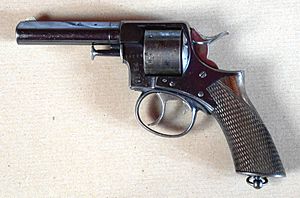
The Crimean War brought a lot of business to Birmingham's gun makers. From 1854 to 1864, over 4 million barrels were tested there. Most military gun stocks were made from walnut wood. For the cheaper African market, common beech wood was used. During the Crimean War, a large saw mill was set up in Turin by a Gun Quarter maker. Nearly 330,000 gun stocks came from this one source.
The Birmingham Small Arms Trade Association supplied many guns during this time. In 1861, 14 of these gunsmiths formed the Birmingham Small Arms Company (BSA).
It is thought that about 800,000 weapons were sent from Birmingham to America. This happened during the American Civil War. One main supplier was William Tranter. He supplied revolvers to the Confederate forces. General Custer owned a Galand and Sommerville .44 revolver. It was faster to load than American pistols of the time.
By the 19th century, the percussion system was introduced. Modern production methods were also adopted. This made Birmingham the main producer of British firearms. A few London makers remained, like the government-owned Royal Small Arms Factory in Enfield. But Birmingham made most of Britain's firearms. During this time, the Gun Quarter made many types of weapons. These ranged from high quality to simpler ones. British weapons were generally well made. They were less fancy than European ones. But they were known for being reliable and well-crafted.
20th Century Changes
When World War I started, the Government again asked Birmingham engineering companies to make arms. Within weeks, Birmingham and the Gun Quarter prepared for ammunition and gun making. Many workers were women. This was because men had joined the armed forces.
Gun making in the US and Europe became more machine-based. This was a big reason for the decline of Birmingham's gun trade. For centuries, it had relied on skilled craftspeople. Mass-produced, "ready-made" guns started to flood the market in the 1880s. The number of people from Birmingham working in the trade fell. It went from 5,500 in 1881 to 4,100 in 1911.
In the 1960s, many old workshops in the Gun Quarter were torn down. This was part of post-war city planning. The area was split in two by the new Birmingham Inner Ring Road. In 1963, a local newspaper, the Sunday Mercury, announced the 'Death of Gun Quarter'.
Modern Times
Today, only a few gun makers and traders remain in the Gun Quarter. The last large gun and rifle maker in the area is Westley Richards. Because of strict gun laws in the UK, there is a small market for firearms. So, most gun making in Birmingham today is for air guns.
The Gun Quarter has continued to decline in the 21st century. It lost about 25% of its manufacturing jobs between 2003 and 2006. This trend continues, with many empty buildings.
In August 2011, a problem arose. The Birmingham Council decided to change the name of the Gun Quarter. They received a petition from only 50 residents from a local church group. They wanted to change the name to St George and St Chad's Quarter. The Birmingham Post reported on it. In response, over 4,500 people signed a petition not to change the name.
Famous Gunmakers
Many gunmakers have worked in Birmingham. Here are some well-known examples:
- Joseph Bentley – shared patents with Webley & Scott.
- Thomas Bland & Sons – now trades in the USA but still uses Birmingham proof for quality.
- Braendlin and Sommerville – later became Galand and Sommerville.
- A A Brown & Sons – Founded by Albert Arthur Brown. His father, John Joseph Brown, also worked for Webley & Scott, Birmingham Small Arms, and W. W. Greener. The company is still run by Sidney's son Robin Brown and his son Matthew Brown.
- Thomas Chambers – originally from Bristol, made guns in Birmingham from 1753 to 1757.
- Farmer and Galton – supplied weapons to the Company of Merchants in Africa and the British East India Company.
- W. W. Greener – Owned the large Prize Gun Works. The company still makes special guns for collectors today.
- Thomas Ketland – started in the early 18th century and became one of the biggest gun businesses.
- The Kynoch Gun Factory
- Parker Hale – closed down in 2000.
- William Perry – started in 1778, made brass and silver guns, often marked with a London tag.
- Westley Richards – made the famous British Lee–Enfield rifles.
- E. Roberts – specialized in walking stick shotguns.
- William Tranter – a founder of BSA.
- Webley & Scott – famous for pistols and airguns.
Farmer and Galton Gun Manufacturers
In the 18th century, Farmer and Galton Gun Manufacturers were based in Birmingham. They made thousands of firearms. These guns were used by European merchants and African business people in the trade and capture of enslaved people.
James Farmer started his gun business in 1702. Within 30 years, he got money from Samuel Galton senior. Galton eventually took charge of the Birmingham branch on Steelhouse Lane. Guns were in high demand, and Farmer and Galton aimed to meet this need.
Historian Hugh Thomas suggests that by 1765, 150,000 guns had been sent to Africa from Birmingham alone. These guns were traded along with other goods for enslaved people. This is a huge number, considering Birmingham's population was about 30,000 in 1765. This means five times more guns were sent to Africa than there were people in the city.
The growth of Farmer and Galton was shaped by this trade. Between 1742 and 1760, most of their guns were made for export. This was just before Britain's Industrial Revolution. In the 1750s, they were the main supplier of arms to the Committee of the Company of Merchants Trading in Africa. This helped the firm grow fast. It became one of Birmingham's biggest and most successful businesses.


